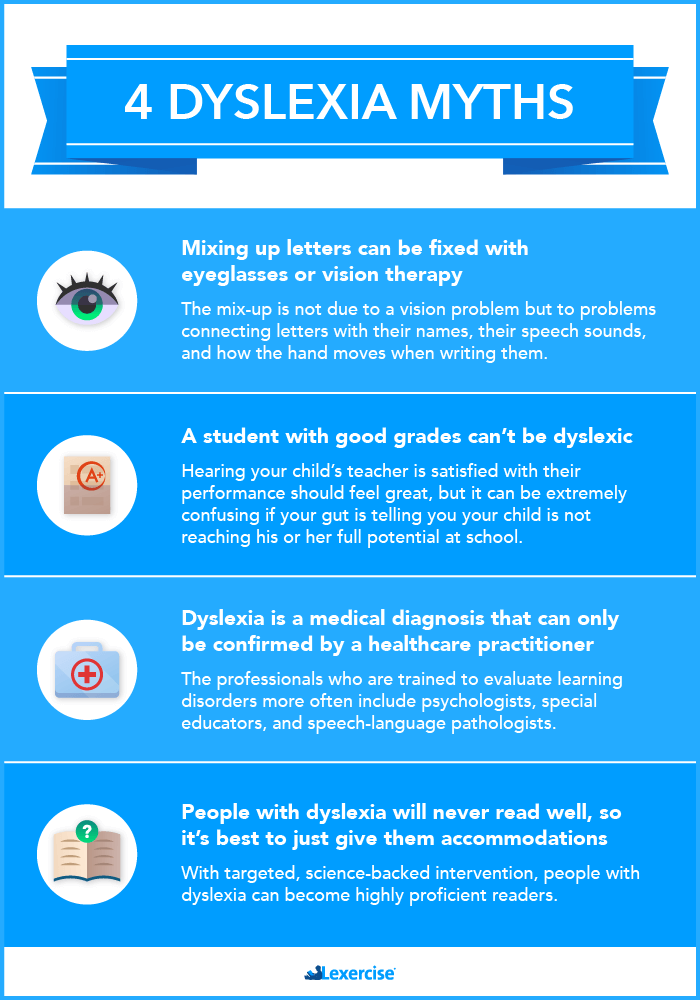4 Dyslexia Myths That Can Confuse Parents
Written by Sandie Barrie Blackley, MA/CCC
Published on September 1, 2022
As Lexercise therapists communicate with the families of children with dyslexia, they are continually impressed by the amount of research parents have done. Getting a dyslexia diagnosis for their child and then finding the right treatment for a student with learning differences is never simple.
At the same time, Lexercise therapists express their surprise and concern at the prevailing myths and misunderstandings surrounding dyslexia. Thanks to these myths, some parents may even be persuaded that their child’s learning difficulties are not treatable.
Below is an infographic that gives you a quick overview of four of these dyslexia myths. Keep on reading for more information.

Here is more information on the four dyslexia myths that persist in spite of solid evidence:
MYTH #1: Dyslexia causes people to see words and letters backward.
In 1925, Dr. Samuel Orton used the term strephosymbolia, literally reversed symbols, in explaining why some people have great trouble reading despite adequate intelligence. A decade later, Orton said that he thought the main problem was actually in “the process of synthesizing the word as a spoken unit from its component sounds.” (See What is Orton-Gillingham and How Does it Treat Dyslexia?)
Since the 1970s, with modern neuroscience technologies, it has become clear that most dyslexics do not have difficulties with vision or visual perception. Instead, most people with dyslexia have difficulties with processing speech sounds. Still, the old idea that dyslexics see words and letters backward or reversed has persisted and become a popular myth. Some recent research suggests that a minority of struggling readers may have difficulty with some aspects of vision, such as visual spatial attention. In his book, Reading in the Brain: the New Science of How We Read, French neuroscientist Dr. Stanislas Dehaene sums up the current science: “…brain imaging supports the claim that the crux of the problem often lies at the interface between vision and speech….” For more information, see a related post by Dr. William O. Young, Five Ways Not to Treat Dyslexia.
MYTH #2: A student who is making good grades must not have dyslexia.
Good grades do not rule out dyslexia! We are going to address common concerns about grade level in an upcoming post, but meanwhile, see 5 Reasons Why Good Grades Don’t Rule Out Dyslexia.
MYTH #3: Dyslexia is a medical diagnosis that can only be used by a healthcare practitioner.
Learning disorders, including dyslexia, have well-documented lifelong negative effects on health and wellbeing, especially when treatment is withheld or delayed. But a learning disorder like dyslexia is not considered a medical diagnosis, nor, in most cases, is the treatment for dyslexia covered by medical insurance.
Neither the World Health Organization’s International Classification of Diseases, 11th Edition (ICD-11) nor the American Psychiatric Association’s Diagnostic and Statistical Manual of Mental Disorders, Fifth Edition, has a specific classification code for dyslexia. Instead, both include reading disorders under a broader category of learning disorders.
Physicians and other medical providers are typically not trained in how to evaluate learning disorders like dyslexia. The exception might be some developmental pediatricians, who have additional training in cognition and learning. The professionals who are trained to evaluate learning disorders more often include psychologists, special educators, and speech-language pathologists. See Who is Qualified to Make a Dyslexia Diagnosis?
MYTH #4: People with dyslexia will never read well, so it’s best to just give them accommodations and other ways to compensate.
With targeted, science-backed intervention, people with dyslexia can become highly proficient readers. In conjunction with appropriate intervention, accommodations and technologies can certainly play a role in reducing fatigue and improving academic performance (see The Limits of Reading Accommodations). It is the appropriate intervention–consistent, targeted therapy plus consistent daily practice–that turns struggling students into confident readers.
To find out more about the diagnosis and treatment of dyslexia, or to learn more about myth-busting dyslexia research, contact Lexercise today.
Improve Your Child’s Reading
Learn more about Lexercise today.
Schedule a FREE
15-minute consultation



Leave a comment